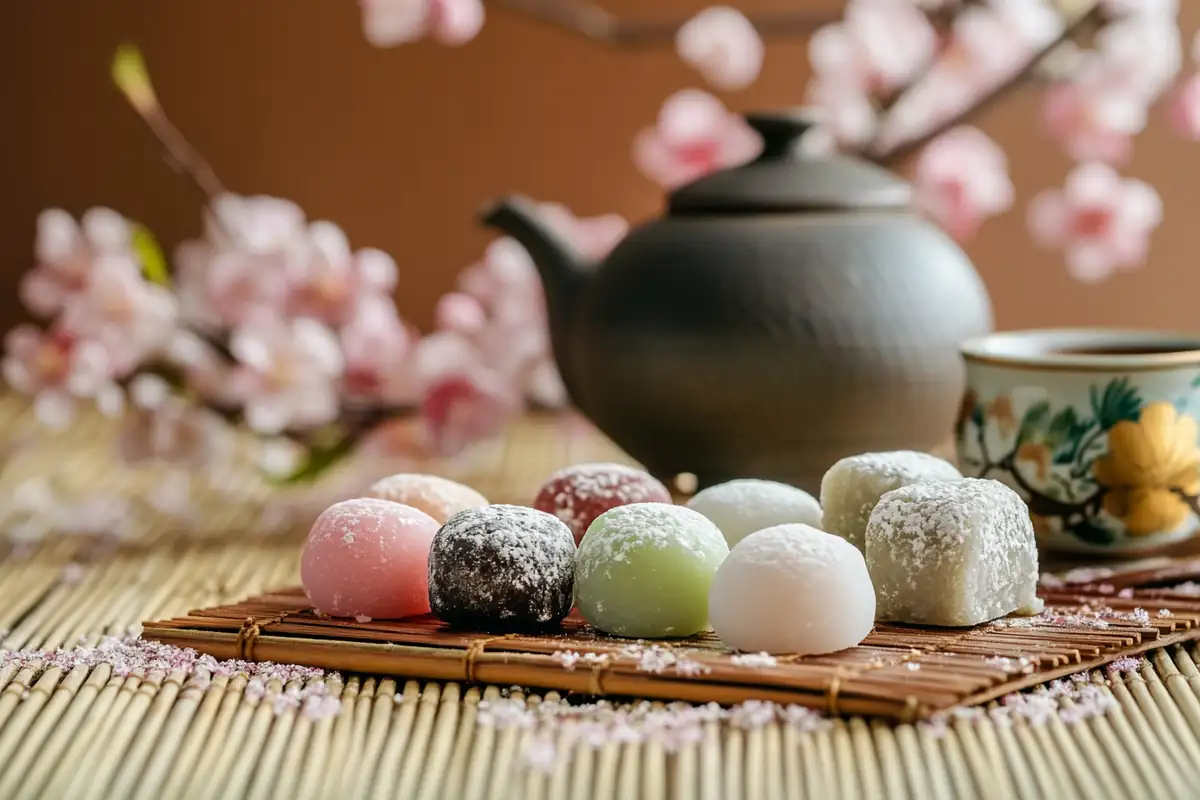Japanese desserts are a world of their own—delicate, artful, and bursting with unique flavors. From the creamy textures of Japanese cheesecakes to the chewy delight of mochi, these sweet treats showcase a perfect balance of simplicity and elegance. Whether you’re a fan of traditional confections like wagashi or modern fusion desserts like matcha tiramisu, there’s something for every palate. This article dives deep into the fascinating world of Japanese dessert recipes, providing an authentic taste of Japan’s sweet side and practical tips for recreating them in your kitchen.
Introduction to Japanese Dessert Recipes
What Makes Japanese Desserts Unique?
Japanese desserts, known as wagashi in traditional contexts, are more than just sweet treats—they’re a reflection of culture, tradition, and the changing seasons. Their uniqueness lies in their minimalistic beauty, the clever use of matcha (green tea), and the delicate incorporation of ingredients like azuki beans and rice flour. Compared to Western desserts, Japanese confections often use less sugar, focusing instead on natural sweetness and subtle flavors.
Moreover, these desserts embrace aesthetics. From the perfectly crafted mochi to the intricate designs of wagashi, each piece tells a story, making them not just food but also an experience. You won’t find anything overly sugary or heavy here. Instead, you’ll enjoy desserts that celebrate harmony and nature.
A Brief History of Japanese Desserts
The roots of Japanese desserts trace back centuries, deeply influenced by Buddhism and tea ceremonies. Wagashi, for example, emerged as a complement to matcha in the traditional tea ceremony, which valued balance and simplicity. The arrival of sugar from China during the Nara period added a sweet twist, sparking the evolution of various confections.
During the Edo period, Japan saw the rise of regional specialties like manju and yokan, while the Meiji period welcomed Western influences, inspiring desserts such as castella cakes. Today, Japanese desserts beautifully combine these historical elements with modern innovation, offering a delicious blend of the old and new.
Traditional Japanese Desserts
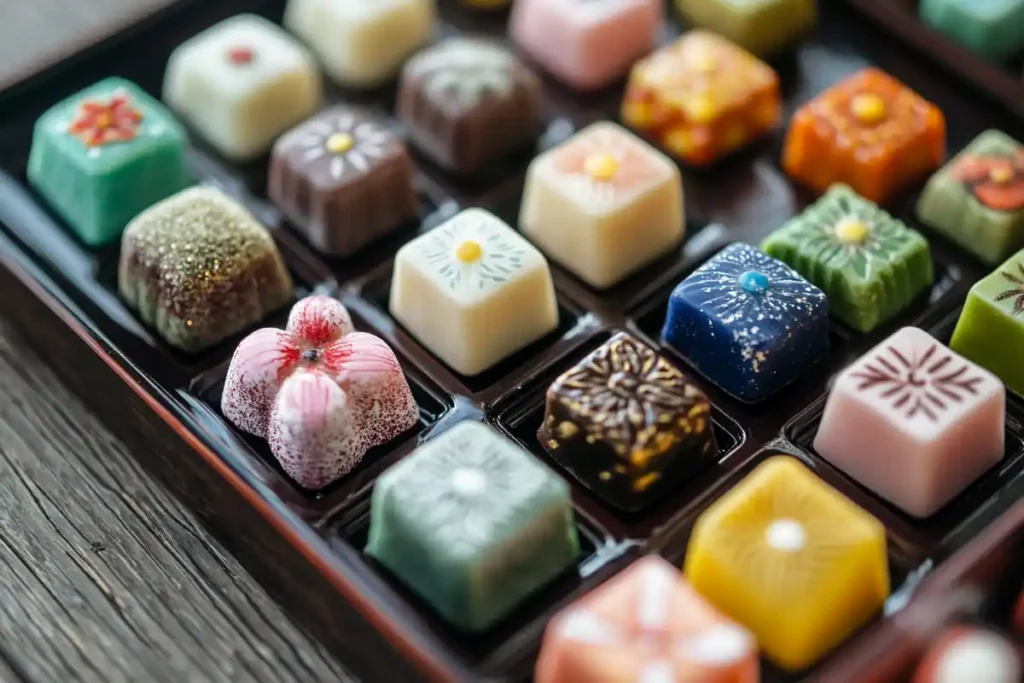
What is the Traditional Sweet of Japan?
When it comes to traditional Japanese sweets, or wagashi, there’s a strong connection between nature, seasonality, and artistry. These desserts often take inspiration from seasonal flowers, leaves, or landscapes, making them as visually stunning as they are delicious.
Wagashi: The Art of Seasonal Sweets
Wagashi represents the soul of traditional Japanese desserts. Artisans handcraft these confections to align with seasonal aesthetics. For instance, spring wagashi often features cherry blossom designs, while autumn varieties showcase maple leaves or chestnuts. Beyond their beauty, people frequently pair them with matcha to balance the tea’s bitterness with their mild sweetness.
Mochi Variations
Mochi, made from glutinous rice flour, is a versatile dessert staple. Its chewy texture and subtle taste make it an ideal base for various fillings and flavors:
- Daifuku: A soft mochi stuffed with sweetened red bean paste or fruits like strawberries.
- Sakuramochi: A springtime favorite, wrapped in a salted cherry blossom leaf for a unique salty-sweet contrast.
- Kashiwa Mochi: A seasonal treat tied to Children’s Day, filled with red bean paste and wrapped in an oak leaf.
Yokan: Sweet Bean Jelly
Another iconic wagashi is yokan, a firm jelly made from sweetened azuki bean paste and agar. Its smooth texture and refined flavor make it a favorite during tea ceremonies. It comes in two main forms—neryo yokan (thick and firm) and mizu yokan (soft and jelly-like, often served chilled in summer).
Key Traditional Flavors
Japanese desserts are celebrated for their distinct flavors, many of which might be unfamiliar to a Western palate but are undoubtedly intriguing.
- Matcha (Green Tea): Known for its vibrant green hue and slightly bitter taste, matcha is a cornerstone in Japanese desserts. From matcha mochi to matcha-flavored yokan, it adds depth and complexity to sweet treats.
- Azuki Beans (Red Bean Paste): Sweetened azuki paste, or anko, is used in countless desserts, offering a nutty and earthy sweetness. It’s often found in mochi, dorayaki, and taiyaki.
- Kinako (Roasted Soybean Flour): Kinako brings a nutty, toasted flavor to desserts like warabi mochi. It’s often paired with sweet syrup for a delightful balance.
Traditional Japanese desserts are not just delicious—they’re an embodiment of history, culture, and an appreciation for nature’s fleeting beauty.
Modern Japanese Desserts
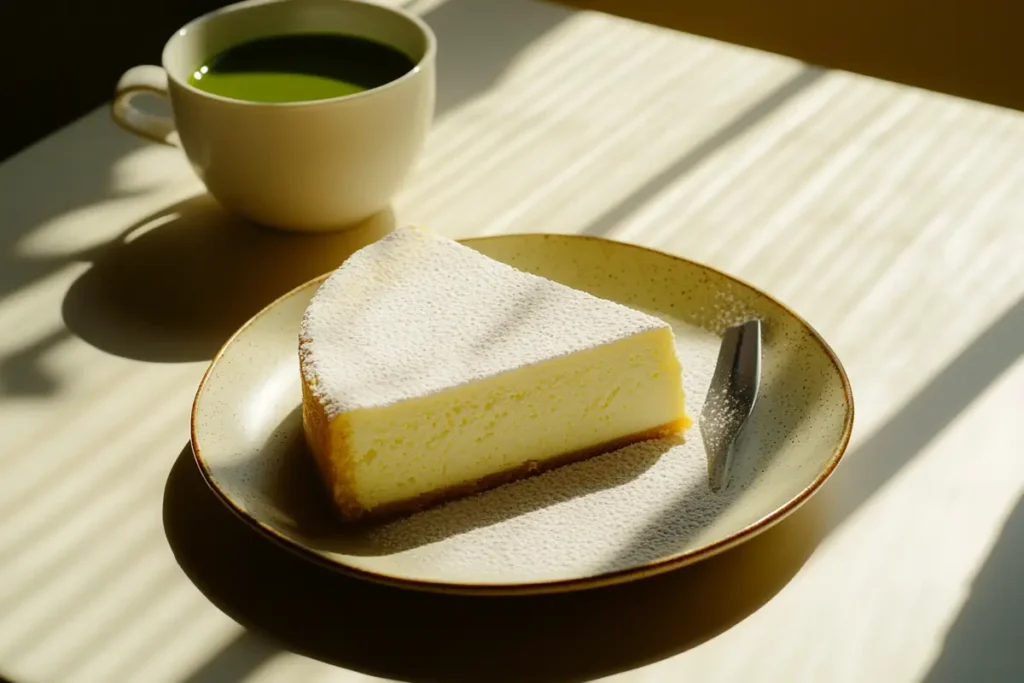
Fusion Desserts
Modern Japanese desserts boldly embrace fusion cuisine, blending traditional elements with Western influences. This approach produces exciting and innovative treats that people worldwide now adore.
Matcha Tiramisu
Matcha tiramisu is a beautiful marriage of Italian and Japanese flavors. This dessert swaps the classic espresso for matcha, layering creamy mascarpone cheese with matcha-soaked sponge cake. The result? A rich yet refreshing twist on a timeless dessert.
Japanese Soufflé Pancakes
If you’ve ever seen towering, jiggly pancakes on social media, you already know about Japanese soufflé pancakes. Chefs whip egg whites to create these airy delights and achieve their signature fluffiness. They often serve them with fresh cream, syrup, or fruit, showcasing how Japanese chefs transform the ordinary into the extraordinary.
Popular Modern Sweet Treats
Traditional desserts carry deep historical roots, but modern innovations captivate dessert lovers with whimsical designs and unique textures.
Japanese Cheesecake
Light, fluffy, and less dense than Western cheesecakes, Japanese cheesecake (sometimes called “cotton cheesecake”) is famous for its cloud-like texture. The dessert’s subtle sweetness and airy consistency make it a favorite across all age groups.
Taiyaki with Ice Cream
Taiyaki, the classic fish-shaped pastry filled with red bean paste, has undergone a delightful transformation. Modern versions are often filled with ice cream, custard, or chocolate, making them a fun and refreshing dessert for hot days.
Parfaits and Kakigori (Shaved Ice)
Japanese parfaits are layered works of art, featuring fruits, syrups, whipped cream, and often a scoop of matcha or azuki-flavored ice cream. Meanwhile, kakigori, a traditional shaved ice dessert, has also evolved into an Instagram-worthy treat with layers of condensed milk, fresh fruits, and even matcha syrup.
Modern Japanese desserts combine creativity with timeless flavors, offering an endless variety of sweet experiences for every taste.
Popular Ingredients in Japanese Desserts
Common Ingredients
Japanese desserts often feature simple, wholesome ingredients that contribute to their unique textures and flavors. These staples are essential for creating both traditional and modern confections.
Glutinous Rice Flour
Known as mochiko or shiratamako, glutinous rice flour is the backbone of many desserts, including mochi and daifuku. Its stretchy, chewy texture is unmatched, providing the characteristic bite that defines these sweets.
Sweetened Condensed Milk
Often used in modern treats like kakigori (shaved ice), sweetened condensed milk adds a creamy sweetness that balances the lightness of other ingredients. Its smooth texture makes it a favorite topping for both traditional and fusion desserts.
Miso and Soy Sauce
While these ingredients might seem unusual in desserts, their savory notes enhance the sweetness of Japanese confections. For example, soy sauce is occasionally incorporated into caramel-like syrups for desserts, adding depth and umami.
Seasonal Ingredients
Japan’s deep connection to the seasons is reflected in its desserts. Seasonal ingredients bring freshness and a sense of celebration to each creation.
Fresh Strawberries
Japanese strawberries are prized for their sweetness and are often paired with desserts like ichigo daifuku (strawberry mochi) or parfaits. Their vibrant red color also makes them a visually stunning addition.
Sweet Potatoes
Rich, earthy, and naturally sweet, Japanese sweet potatoes are commonly used in desserts like yokan or as a filling for pastries. Their creamy texture and subtle flavor are particularly comforting during autumn.
Chestnuts
Chestnuts, or kuri, are a quintessential ingredient in autumnal desserts. They’re often candied or pureed into a creamy filling for wagashi or seasonal cakes, adding a nutty sweetness that’s both nostalgic and indulgent.
Popular Japanese dessert ingredients embody simplicity and balance, celebrating the natural flavors of each component. By combining these elements with seasonal touches, Japanese sweets create an unparalleled dessert experience.
Top 10 Must-Try Japanese Dessert Recipes
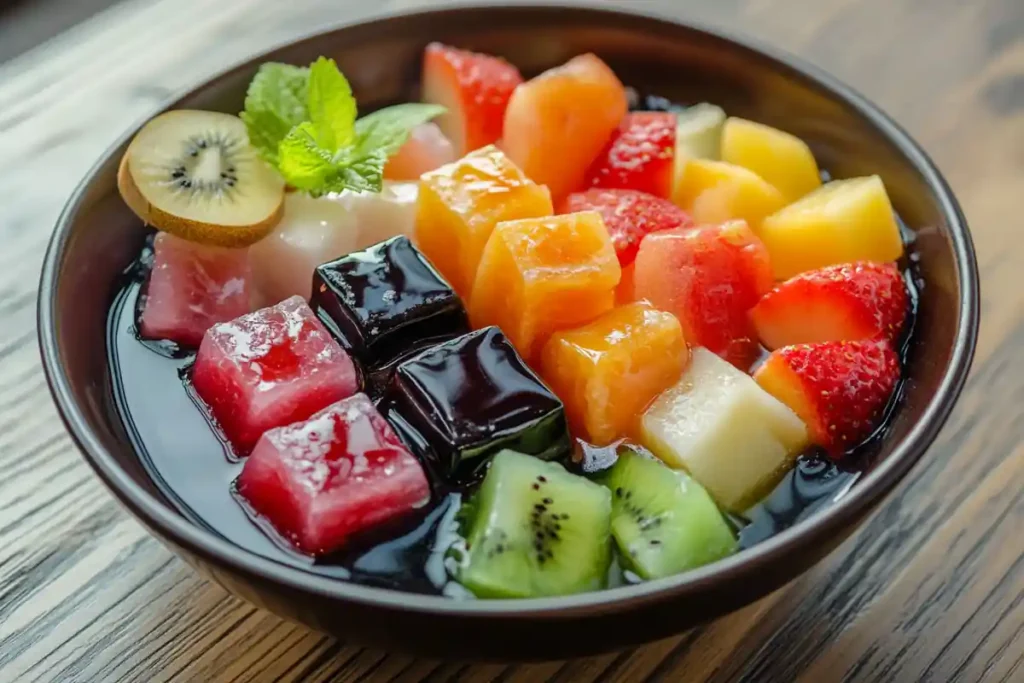
Recipe 1: Mochi Ice Cream
Mochi ice cream is a delightful blend of traditional mochi and modern ice cream. Its chewy rice flour exterior encases creamy ice cream, creating a fun textural contrast. To make it at home:
- Wrap small scoops of ice cream in flattened pieces of mochi.
- Freeze until firm, and enjoy a handheld dessert that’s perfect for summer.
Recipe 2: Matcha Pudding
This silky-smooth dessert brings the earthy flavor of matcha to a creamy custard. To prepare:
- Blend matcha powder, milk, sugar, and gelatin, then chill until set.
- Serve with a dollop of whipped cream for a perfect balance of bitter and sweet.
Recipe 3: Dorayaki (Pancake Sandwiches)
Dorayaki features fluffy pancakes filled with sweet anko (red bean paste). It’s a quick and satisfying snack:
- Whisk eggs, sugar, and honey into a batter, then cook on a hot skillet.
- Sandwich a generous amount of anko between two pancakes, and serve warm.
Recipe 4: Taiyaki (Fish-Shaped Pastry)
Taiyaki is a street-food favorite filled with either anko, custard, or chocolate. For homemade taiyaki:
- Pour batter into a fish-shaped mold, add your preferred filling, and cook until golden.
- Serve warm with a crispy exterior and gooey center.
Recipe 5: Anmitsu (Sweet Jelly Dessert)
Anmitsu is a refreshing dessert featuring cubes of agar jelly, fresh fruits, and sweet syrup. To assemble:
- Combine agar jelly with diced fruits, red bean paste, and mochi balls.
- Drizzle with black sugar syrup for a balanced sweetness.
Recipe 6: Japanese Cotton Cheesecake
Famous for its fluffy texture, Japanese cotton cheesecake is an airy take on a classic dessert:
- Fold whipped egg whites into a cream cheese batter for a light, cloud-like result.
- Bake in a water bath to achieve a soft and delicate crumb.
Recipe 7: Matcha Swiss Roll
This rolled cake combines the richness of buttercream with the distinct flavor of matcha:
- Bake a thin sponge cake infused with matcha.
- Spread matcha-flavored cream across the surface, then roll tightly for a striking swirl.
Recipe 8: Wagashi (Seasonal Confectionery)
Handcrafted wagashi reflects seasonal beauty and traditional craftsmanship:
- Use mochi or sweetened red bean paste to shape delicate flowers or fruits.
- These desserts are as much about art as they are about flavor.
Recipe 9: Daifuku (Stuffed Mochi)
Daifuku is a simple yet versatile dessert with various filling options:
- Wrap a thin layer of mochi around sweet fillings like anko or fresh strawberries.
- Roll in cornstarch to prevent sticking, and enjoy this chewy delight.
Recipe 10: Kakigori (Shaved Ice Dessert)
Perfect for summer, kakigori is shaved ice topped with syrups and condensed milk:
- Shave ice finely, then drizzle with flavored syrups like matcha or strawberry.
- Add a touch of sweetened condensed milk or fruit for extra indulgence.
These ten recipes provide a wonderful introduction to Japanese desserts, showcasing their variety, flavors, and simplicity in preparation.
Tips for Making Authentic Japanese Desserts
Equipment Essentials
Creating authentic Japanese desserts often requires specialized tools, but don’t worry—most of them are accessible and easy to use. Here’s what you’ll need to get started:
Bamboo Steamer
A bamboo steamer is essential for steaming delicate desserts like mochi or manju. Its natural material ensures even heat distribution, preserving the soft texture of these treats.
Rice Cooker
While rice cookers are typically associated with savory dishes, they’re a game-changer for preparing sticky rice used in mochi or ichigo daifuku. Their precise cooking method ensures consistency every time.
Secrets for Authenticity
To truly capture the essence of Japanese desserts, it’s important to focus on both ingredients and techniques.
Balancing Sweetness
Unlike many Western desserts, Japanese confections are known for their subtle sweetness. Avoid overloading on sugar, and let the natural flavors of ingredients like azuki beans, matcha, or fruits shine through.
Using Fresh, High-Quality Ingredients
Authenticity begins with freshness. Opt for premium-grade matcha, high-quality glutinous rice flour, and fresh fruits like strawberries or chestnuts. Even a simple dessert can feel luxurious when made with the best ingredients.
Attention to Aesthetics
Japanese desserts are as much about appearance as they are about taste. Take your time to shape mochi, pipe cream, or layer parfaits neatly. A little extra effort in presentation can elevate your dessert from delicious to extraordinary.
Mastering these tips will not only enhance your results but also deepen your appreciation for the artistry of Japanese sweets.
FAQs About Japanese Desserts
What is the most popular dessert in Japan?
Mochi is the most popular Japanese dessert, with varieties like daifuku and mochi ice cream being fan favorites.
What are the 9 common desserts?
Nine common desserts include mochi, dorayaki, taiyaki, anmitsu, wagashi, matcha swiss roll, Japanese cheesecake, yokan, and kakigori.
What is ice dessert in Japanese?
Ice dessert in Japanese is called kakigori, a shaved ice treat topped with syrups, fruits, or condensed milk.
What is the traditional sweet of Japan?
The traditional sweet of Japan is wagashi, crafted from rice, beans, and fruits, often enjoyed during tea ceremonies.
Print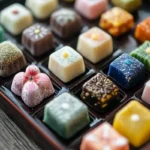
Dorayaki (Japanese Red Bean Pancakes)
- Total Time: 35 minutes
- Yield: 6 Dorayaki 1x
Description
Dorayaki is a popular Japanese confection consisting of two fluffy, honey-flavored pancakes filled with sweet red bean paste (anko). This delightful treat is perfect as a snack or dessert and pairs wonderfully with green tea.
Ingredients
For the Pancakes:
- 2 large eggs
- 3 tablespoons granulated sugar
- 1 tablespoon honey
- 1/2 teaspoon vanilla extract
- 1 cup all-purpose flour
- 1 teaspoon baking powder
- 3 tablespoons water
For the Filling:
- 1 cup sweet red bean paste (anko, smooth or chunky based on preference)
Instructions
- Prepare the Pancake Batter:
- In a mixing bowl, whisk together eggs, sugar, honey, and vanilla extract until well combined and frothy.
- Sift in the all-purpose flour and baking powder. Mix gently until the batter is smooth.
- Add water, one tablespoon at a time, to achieve a thick but pourable consistency. Let the batter rest for 15 minutes.
- Cook the Pancakes:
- Heat a non-stick skillet over medium-low heat and lightly grease with oil or cooking spray.
- Pour about 2 tablespoons of batter onto the skillet to form small, round pancakes (about 3 inches in diameter).
- Cook until bubbles appear on the surface and the edges look set (1-2 minutes). Flip and cook the other side for 30 seconds. Remove from heat. Repeat with the remaining batter.
- Assemble the Dorayaki:
- Spread 1-2 tablespoons of red bean paste on the flat side of one pancake.
- Place another pancake on top, flat side down, to form a sandwich. Gently press the edges to seal.
- Serve:
- Enjoy your Dorayaki immediately or wrap them in plastic wrap to keep them moist and serve later.
Notes
- For an alternative filling, try custard cream, matcha-flavored bean paste, or even chocolate spread.
- Ensure the skillet is not too hot to prevent overbrowning.
- Prep Time: 15 minutes
- Cook Time: 20 minutes
- Category: Dessert
- Method: Stovetop
- Cuisine: Japanese
Nutrition
- Calories: 210
- Sugar: 15g
- Sodium: 55mg
- Fat: 2g
- Saturated Fat: 0.5g
- Unsaturated Fat: 1.5g
- Trans Fat: 0g
- Carbohydrates: 40g
- Fiber: 2g
- Protein: 5g
- Cholesterol: 45mg
Keywords: Dorayaki, Japanese Dessert, Pancakes, Anko, Sweet Red Bean

